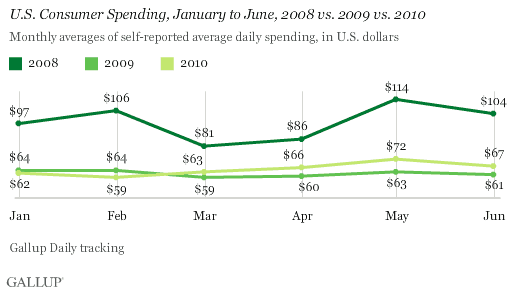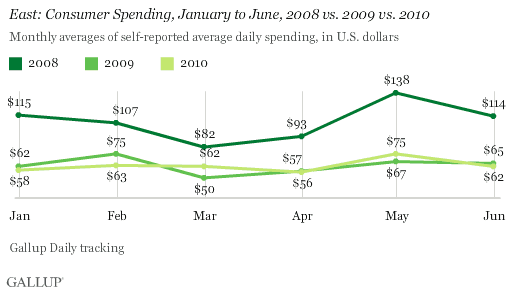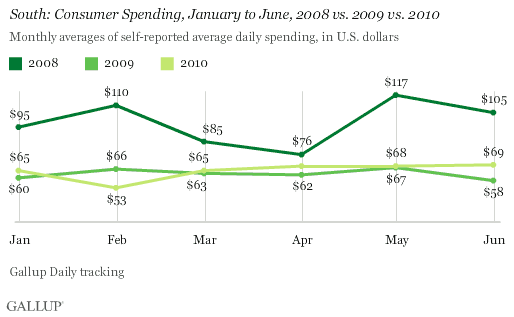PRINCETON, NJ -- Americans report spending an average of $67 per day during June in stores, restaurants, gas stations, and online -- down $5 from May 2010, but up $6 from June 2009. Consumer discretionary spending thus remains at the upper end of the 2009 monthly new normal range ($59 to $67), but far below the 2008 spending range ($81-$114).

Consumer spending is flat in the Midwest and South in June compared with May 2010, and down in the East and West. Year-over-year spending is up sharply in the Midwest -- the top spending region in June -- and the South. However, it is down slightly in the East and down somewhat more in the West.
East: Down From May 2010 and June 2009
Americans in the East reported spending an average of $62 per day in June, down $13 from May and $3 from a year ago. Their spending remains far below the $114 average of June 2008. Easterners' spending seems to have stabilized after the financial crisis and given the improved outlook for financial institutions.

Midwest: Flat Compared With May and Up Sharply From June 2009
Americans in the Midwest spent about the same amount in June as in May. At the same time, the much-improved U.S. manufacturing situation has spending in this region up sharply from a year ago. As is true in other regions, spending in June 2010 trails that of June 2008.

South: Flat in June 2010 but Up From June 2009
In the South, spending averaged $69 per day in June -- essentially the same as in May, and up $11 from June of a year ago. However, average spending here remains far below the $105 average of June 2008. Energy prices have remained high in 2010 and this may have helped income and spending in the South. While the Gulf oil spill is hurting many forms of spending in this region, the cleanup effort itself may be something of an offsetting factor, at least in the immediate term.

West: Down Compared With May and June 2009
Spending in the West was down in June compared with May 2010 and June 2009, and was far below 2008 levels. The housing difficulties in the West continue to depress overall spending in the region.

Spending Not Much Different From the 2009 New Normal
Americans' discretionary spending during the first half of 2010 has been generally consistent with the 2009 "new normal" spending range. Over the past couple of months, spending nationwide has been at or slightly above the upper end of the new normal range, as spending in the Midwest has shown significant improvement and as "frugality fatigue" among upper-income consumers had its moment in May.
Further, Gallup modeling suggests that spending improves as job market conditions get better. In this regard, it is not surprising that spending is highest in the Midwest and South where June job market conditions are best, according to Gallup's Job Creation Index.
While the slightly better spending of the first six months of 2010 is also consistent with a more stable and slowly expanding economy, it is nowhere near the strong upturn many on Wall Street, as well as retailers on Main Street, had hoped to see when spending picked up earlier this year. Americans' self-reported spending remains far below that of 2008 -- and that was a recession year.
Given the current jobs picture, the weak financial and equity markets, the lack of recovery in housing, and the global move toward fiscal austerity, it is hard to envision the short-term catalyst that will get Americans' spending to return to 2008 levels or something even better. As a result, retailers may want to plan for a continuation of the spending new normal during the second half of 2010.
Gallup.com reports results from these indexes in daily, weekly, and monthly averages and in Gallup.com stories. Complete trend data are always available to view and export in the following charts:
Daily: Employment, Economic Confidence and Job Creation, Consumer Spending
Weekly: Employment, Economic Confidence, Job Creation, Consumer Spending
Read more about Gallup's economic measures.
Survey Methods
Results are based on telephone interviews conducted as part of Gallup Daily tracking June 1-30, 2010, with a random sample of 14,853 adults, aged 18 and older, living in all 50 U.S. states and the District of Columbia, selected using random-digit-dial sampling.
For results based on the total sample of national adults, one can say with 95% confidence that the maximum margin of sampling error is ±1 percentage point.
Interviews are conducted with respondents on landline telephones and cellular phones, with interviews conducted in Spanish for respondents who are primarily Spanish-speaking. Each daily sample includes a minimum quota of 150 cell phone respondents and 850 landline respondents, with additional minimum quotas among landline respondents for gender within region. Landline respondents are chosen at random within each household on the basis of which member had the most recent birthday.
Samples are weighted by gender, age, race, Hispanic ethnicity, education, region, adults in the household, cell phone-only status, cell phone-mostly status, and phone lines. Demographic weighting targets are based on the March 2009 Current Population Survey figures for the aged 18 and older non-institutionalized population living in U.S. telephone households. All reported margins of sampling error include the computed design effects for weighting and sample design.
In addition to sampling error, question wording and practical difficulties in conducting surveys can introduce error or bias into the findings of public opinion polls.
For more details on Gallup's polling methodology, visit https://www.gallup.com/.
